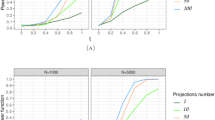Summary
For an Euclidean groupG acting freely on the parameter space, we derive, among several noninformative priors, the reference priors of Berger-Bernardo and Chang-Eaves for our parameter of interest θ1, a scalar maximal invariant parametric function. Identifying the nuisance parameter vector with the group element, we derive a simple structure of the information matrix which is used to obtain different noninformative priors. We compare these priors using the marginalization paradox and the probability-matching criteria. The Chang-Eaves and the Berger-Bernardo reference priors appear to be the most attractive choice. Several illustrative examples are considered.
Similar content being viewed by others
References
Bayarri, M. J. (1981). Inferencia Bayesiana sobre el coefficiente de correlación de una población normal bivariante.Trab. Estadist. 32, 18–31.
Berger, J. (1985).Statistical Decision Theory and Bayesian Analysis. Second Edition. New York: Springer Verlag.
Berger, J. (1992). Discussion of Ghosh and Mukerjee.Bayesian Statistics 4 (J. M. Bernardo, J. O. Berger, A. P. Dawid and A. F. M. Smith, eds.), Oxford: University Press4, 205–206.
Berger, J. and Bernardo, J. M. (1989). Estimating a product of means: Bayesian analysis with reference priors.J. Amer. Statist. Assoc. 84, 200–207.
Berger, J. and Bernardo, J. M. (1992a). On the development of the reference prior method.Bayesian Statistics 4 (J. M. Bernardo, J. O. Berger, A. P. Dawid and A. F. M. Smith, eds.), Oxford: University Press, 35–60, (with discussion).
Berger, J. and Bernardo, J. M. (1992b). Ordered group reference priors with applications to the multinomial problem.Biometrika 79, 25–37.
Chang, T. and Eaves, D. (1990). Reference priors for the orbit in a group model.Ann. Statist. 8, 1595–614.
Cox, D. R. and Reid, N. (1987). Orthogonal parameters and approximate conditional inference.J. Roy. Statist. Soc. B 49, 1–39, (with discussion).
Datta, G. S. and Ghosh, J. K. (1994). Noninformative priors for maximal invariant parameter in group models.Tech. Rep. 94-4, Dept. of Statistics, University of Georgia.
Datta, G. S. and Ghosh, J. K. (1995). On priors providing frequentist validity for Bayesian inference.Biometrika 82, 37–45.
Dawid, A. P., Stone, M. and Zidek, J. V. (1973). Marginalization paradoxes in Bayesian and structural inferences.J. Roy. Statist. Soc. B 35, 189–233, (with discussion).
Geisser, S. (1965). Bayesian estimation in multivariate analysis.Ann. Math. Statist. 36, 150–159.
Ghosh, J. K. (1994).Higher Order Asymptotics. IMS and ASA. Hayward, California, USA.
Ghosh, J. K. and Mukerjee, R. (1992a). Non-informative priors.Bayesian Statistics 4 (J. M. Bernardo, J. O. Berger, A. P. Dawid and A. F. M. Smith, eds.), Oxford: University Press, 195–210, (with discussion).
Ghosh, J. K. and Mukerjee, R. (1992b). Bayesian and frequentist Bartlett corrections for likelihood ratio and conditional likelihood ratio tests.J. Roy. Statist. Soc. B 54, 867–75.
Lehmann, E. L. (1986).Testing Statistical Hypotheses, Second Edition. New York: Wiley.
Lindley, D. V. (1965).Introduction to Probability and Statistics from a Bayesian Viewpoint. Cambridge: University Press.
Muirhead, R. J. (1982).Aspects of Multivariate Statistical Theory. New York: Wiley.
Peers, H. W. (1965). On confidence points and Bayesian probability points in the case of several parameters.J. Roy. Statist. Soc. B 27, 9–16.
Stein, C. (1985). On the coverage probability of confidence sets based on a prior distribution.Sequential Methods in Statistics. Banach Center Publications 16, Warsaw PWN, Polish Scientific Publishers, 485–514.
Tibshirani, R. J. (1989). Noninformative priors for one parameter of many.Biometrika 76, 604–8.
Wijsman, R. A. (1990).Invariant Measures on Groups and their Use in Statistics. IMS. Hayward, California, U.S.A.
Ye, K. and Berger, J. (1991). Noninformative priors for inferences in exponential regression models.Biometrika 78, 645–56.
Author information
Authors and Affiliations
Rights and permissions
About this article
Cite this article
Datta, G.S., Ghosh, J.K. Noninformative priors for maximal invariant parameter in group models. Test 4, 95–114 (1995). https://doi.org/10.1007/BF02563105
Received:
Revised:
Issue Date:
DOI: https://doi.org/10.1007/BF02563105



